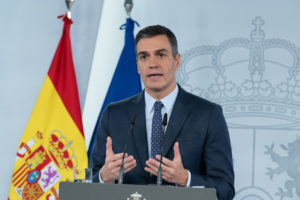
The Spanish Government has decreed a “State of Emergency” to provide regions – including Murcia – with full constitutional coverage to tackle the coronavirus pandemic according to their specific needs.
The “Estado de Alarma” (as it is classified in Spanish) came into effect on Sunday afternoon after an extraordinary meeting of the Spanish cabinet. The Royal Decree declared an initial 15-day “State of Emergency” which the government said it wanted to extend a further six months to 9 May, in response to the “situation of special risk stemming from the COVID-19 virus”.
The government requires parliamentary approval for an extension but it is expected to have sufficient support for a majority in favour when the motion is put to a sitting of the parliament (Cortes) – presumably this week.
In an official statement following the decision, the government said, “The six-month term is considered necessary, based on scientific criteria and expert recommendations, to start to overcome the current second wave of the pandemic in its harshest phase.
“The ‘State of Emergency’ is shaped as a legal provision that allows limitations on mobility and contacts to be set so that the regional governments that consider it necessary can apply this with all due constitutional guarantees.”
The declaration was approved in response to a request from 10 of Spain’s 17 regional governments (Basque Country, Asturias, Extremadura, La Rioja, Cataluña, Navarre, Cantabria, Valencia, Castilla La Mancha and the Balearic Islands), plus the autonomous city of Melilla, following a proposal from the national government.
Regional presidents, including those who didn’t formally seek the decree, will have delegated jurisdiction in their respective regions, and will be able to decide the level of application of the decree measures, according to their respective situations.

Mobility Limitations
So what limits are there on freedom of movement? According to the government, a general prohibition is established on night-time mobility between 11 pm and 6 am, although each regional government may modify the start from between 10 pm and midnight and the end from between 5 am and 7 am. Its application will cover the whole country except the Canary Islands, due to its “better epidemiological situation”.
During this timetable, “it will only be possible to travel on justified grounds, such as to purchase medication, comply with labour obligations, care for the elderly and children, and return home”.
The regional governments may also decide on limitations on the arrival to and departure from their regions, covering the whole or part of the region. In addition, they may limit the presence of people in public or private spaces to a maximum of six, not including those who cohabit.
Action Criteria
The regional governments will base their actions on indicators and criteria agreed last week by the inter-territorial council of the national health system, relating to the number of infections, care and public health capacity, and the population’s characteristics and vulnerability.
Four risk levels are established for each region: low, medium, high and extreme. The main criteria are as follows:
The number of cases detected per 100,000 inhabitants over the last 14 days… A rate below 25 cases per 100,000 inhabitants is considered a low risk and above this as a medium risk. A rate of 150 cases is considered a high risk and above 250 cases per 100,000 inhabitants an extreme risk.
This indicator is completed with the level of cases over the last seven days, the specific rate for those over 65 years (considered the group most vulnerable to COVID-19), the number of positive cases according to tests carried out in each region, and the percentage of cases that are traced (i.e. where the origin of the infection is precisely known).
Also taken into account is the occupancy level of hospital services and intensive care beds. A very high risk situation exists if the number of beds occupied by COVID-19 patients exceeds 15 per cent of global hospital admissions and 25 per cent of intensive care unit (ICU) beds.
The inter-territorial council will meet on a weekly basis, so that its members (national minister for health Salvador Illa and all the regional health ministers) can “assess the weekly situation and establish a coordinated health response”.
Regional Resources
The regional governments have been allocated €16 billion from the non-repayable fund set up by the government to “help them combat the effects of the pandemic, finance spending on health and education, offset the loss of revenue and lay the foundations for socio-economic recovery”.
They have also been provided with 5,686 service personnel from the armed forces to help in contact tracing, of which 1,740 have already been deployed; and a common strategic reserve has been set up with more than 512 million surgical face masks, 57.6 million FFP2 face masks and nearly two million antigen tests.
Murcia has been taking steps for several months to ensure it is one of the safest regions in Spain for residents and tourists.
